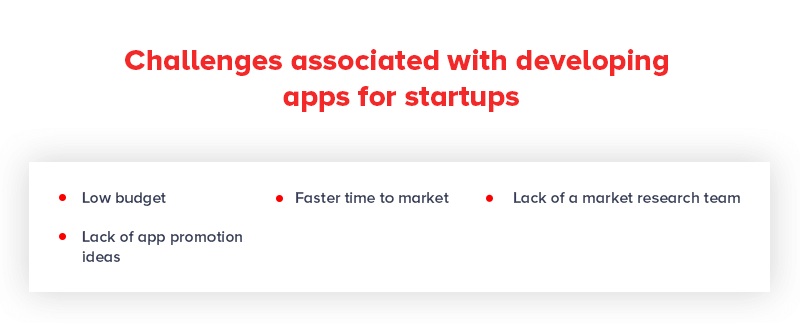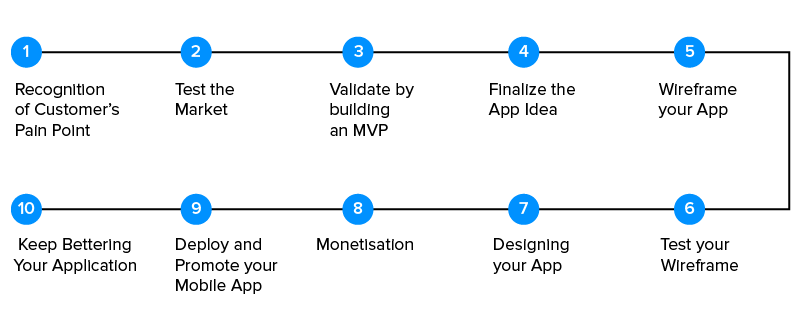10 Steps Roadmap to Successful App Development for Startups
The difference between Startups and Established Brands are too evidential and innumerable to ignore or list down.
Having worked with both, we understand first hand that both the entities are different not just work or culture wise, but the difference also seeps into their business model and their expectations in terms of deliveries.
While on one hand established brands, with their no shortage of funds and lower go-to market time, focus their attention on the app quality, Startups usually seek faster time to market and supreme quality at low development cost.
This difference in idea brings in a difference in deliverables as well, especially when it comes to the delivery of a product that is an extension of the brand, showcased on a platform accessed by millions of users.
The product here being mobile apps.
In this article, we will look into the different challenges startup app development poses. And will give you a roadmap for app development highlighting how to go about it as a startup.
Startup’s Mobile App Development Challenges

1. Low budget
Startups usually come with a limited budget and even within that limited budget, they have to divide the funds between research, development, launch of app on the stores and its promotion after it is made live. This lack of budget is the number one reason behind the brands not investing in a mobile app development company for startups.
2. Faster time to market
Startups are more often than not in a race to come on top of the competition in the market. And in that respect, they end up looking at white label solutions, even if it means getting a low quality product.
3. Lack of a market research team
Since in most cases, startups are made of a team of 2 to 10 people, the chances that they would have a team specializing in finding the mobile app solution for a startup is very minimal.
This absence of a research team – one of the crucial steps in developing an app – makes it very difficult for them to find out more about their customers.
4. Lack of app promotion ideas
Noting the low budgets, the biggest problem that emerges in the mobile app development steps when it comes to mobile app development for startup is limitation in terms of app marketing or promotion once it is launched on the stores.
Now that we have looked into the different challenges that the SMBs face when it comes to investing in software development for startups, let us now give you a roadmap for mobile app development that we at Appinventiv follow in our role as a web and mobile app development company for startups. Ones that enlist the best steps to developing an app
10 Step Application Development Roadmap

Hopefully, by the time you’re done reading this post, you’ll have gained valuable insights to turn your mobile app idea into a money-generating machine – all at the back of this strategically enlisted app development roadmap.
Let’s get started-
1. Recognition of Customer’s Pain Point-
A thorough understanding of the problem and the customer’s pain is the first step towards successful application development that is to be followed by both startups and established brands. In case you don’t have the support of a team that would handle the market research part for you, invest in a startup app development company that understands the nerves of a market.
Come to think of it, if you don’t know the underlying problem, how can you even consider designing a product which provides an appropriate solution to its consumers. Identifying your customer’s pain points and then working on developing a solution that cures their pain is what that takes you miles ahead of other competitors.
As a business owner, your ability to discover what your audience is struggling with and assuring them that you genuinely care about their problems and are ready to help them is half the battle won. In fact, it is the app discovery stage that decides the survival ability of your app.
In this oversaturated market of mobile apps startups, what makes you a key differentiator is the fact that you realize the “real needs” of your customer and then plan or devise a product or an app which caters to those actual needs. And your extra ability to adjust and adapt to these ever-changing needs of your audience is what all the more gives you a competitive edge over other mobile app builders.
In essence, it helps you define a clear goal and mission for your mobile app.
2. Test the market
A good and deep market study to validate your idea is a crucial step. A step that shouldn’t be skipped as it ensures that your idea is worth the time, energy and money that you are investing.
Even if you are planning to not involve a startup app development company at this stage, do a preliminary research from your end. Analyze the competitive landscape to find out whether your idea is truly profitable or not is absolutely essential. Ultimately, you want to make sure that your product has a fairly large market demand.
This is how to go about it –
- Google Trends is an excellent tool to find out if the search volumes revolving around your idea’s keywords is advancing or diminishing.
- Conducting small surveys consisting of questions that relate to your app idea is extremely beneficial. Questions circling around their phone usage and their favourite apps help paint a picture for you as to what all fine-tuning your app needs.
- Competition analysis – It is a part of the market analysis. Apart from determining your target future audience and their needs, you are also enlightened with the size of competition that you would be facing. Analysis of your competitors before launching your mobile app startup is a brilliant idea. It provides an assessment of the strengths and weaknesses of current and potential competitors bringing you many steps closer to success
3. Validate by building an MVP
As a startup, you cannot give in to the very common misconception that most people tend to cling to is that you need a perfect version of your product to be displayed to people. There are a number of benefits that come associated with the development of MVP in startup ecosystem.
We should not forget that all the successful apps or products that we see in the market today have gone through hundreds of improvisations and have evolved over a period of time through the consistent customer feedback.
The minimum viable product is the essence of your app which concentrates only on the core features and solves the core problems of your potential customers. In short, it is the simplest and affordable version of your mobile app idea which also makes it one of the most crucial steps to developing an app.
It’s a concept wherein a rough prototype with “must-have features” is rolled out to help us get honest feedback from potential customers and retail partners. It constitutes a great tool to validate your mobile app and also informs us about the aspects that need to be worked upon.
4. Finalize the App Idea
Once you have the needed market knowledge and have insights on what your audience needs are, the time has come to finalize a strategic application idea. In order to finalize the concept it helps to bring in your team of designers, coders, business analysts, and QA experts to discuss the different elements of your mobile application.
There are some questions that can help you get closer to validating a suitable app idea. For example:
- Why would someone use your application?
- Is it a one time app or will people use it frequently?
- What are the feature sets which would make you apart from your competitors?
Once you are down with the feature set, design, and the app vision, the next stage that comes is the creation of an MVP – Minimum Viable Product.
5. Wireframe your App
Now that you know that your app is well accepted by its customers and is evoking interest, my next advice would be to wireframe your mobile app.
A wireframe is a structural blueprint of your app that diagrammatically shows the objects on the screen and its possible functions. It has become that phase that you cannot afford to miss out from the mobile app development process.
In common language, it’s more like a plan that architects draw before constructing a house or building or you can call it your app’s skeleton.
Key advantages of wireframing your mobile app-
- You will gain a clear idea as to how your app will look like and how it will work.
- Provides you with a visual illustration as to how different elements(like buttons and menu) will appear on each screen of your application and how the user will navigate through it.
- Any bugs that might later pose a problem can be removed in this stage.
- It also gives an opportunity to update and add more features in the app if you feel like, to ensure the best usability.
6. Test your wireframe
After you have polished your wireframe, it’s time to put it through testing.
Don’t be fooled into thinking that it’s just a dummy or an intermediary product and does not require testing.
Remember, A little examination in this stage goes a long way in saving you from troubles that you may encounter in the long run.
Some key advantages of wireframe testing-
- It’s an ahead of the curve action which is quite useful in determining the usability of the
mobile app in the pre development phase.
- Identification of any requirements that are lacking.
- Recognition of any extra requirements that could be filled in.
- Detection of any loopholes in functionality, user-friendliness and design.
Simply put, the insights that you gain in the testing stage helps you to rectify the existing defects and have access to improvised and clearer version of the prototype before rolling it out in the market.
7. Designing your App
As they say, “For a great product, design cannot be an afterthought.”
And in your case, where you’ll probably take some time before redesigning your app, you will have to ensure that it is proper the first time on. With that respect, now is the time to put all the research done till now to use and translate your tested wireframes into final designs.
Keeping in mind all the comments and feedback of the users, you now know how you want your app to look and feel like.
Designing plays a huge role in the success of an app.
For instance, see Apple, the whole business and culture of the tech giant spins around design excellence. And as Steve Jobs has quoted, “Design is not just what it looks like and feels like. The design is how it works.”
Remember, people love and respond to beautiful things, then how can a mobile app be an exception😊
Having said that, your mobile app design should focus equally on the user experience. A good app design without user-friendliness is no good and will eventually struggle to establish its foothold in the market. Simplifying the journey of your user on your app is WHAT design is all about. The fact is reiterated by the quote, “Design isn’t finished until somebody is using it.”— Brenda Laurel, PhD, Independent Scholar
If you are not short on budget, invest in a team of app designers and developers for startup. But at the same time, what helps is knowing what all elements are presently counted in the list of mobile app UI Design trends.
8. Monetisation
As a startup, it is of prime importance that you have a proper monetization strategy in place. As while established brands can afford to give user engagement a greater importance than monetization, you don’t have the same perk. So, ensure that when you are in talks with a team who has promoted itself as a team of app developers for startups, you clear your aim to make money off of your mobile app, straight away.
In order to achieve this, you will have to know which app monetization strategy is best suited for your mobile app, yourself. Depending on your app concept, there are a number of methods that you can choose from – in app advertisement, freemium apps model, etc.
9. Deploy and Promote your Mobile App.
You are nearly there!
So close to seeing your idea manifest. High time to put on your thinking hats to devise a perfect marketing strategy now.
Needless to say, your marketing plan should be focussed, realistic and specific to your target audience. Don’t expand your marketing budget at this stage on uncharted territories. Focus your attention on promotion medium that will get you definite result.
With that said, here are some sureshot ways to promote your app-
- Social media marketing
- Public relations
- Email marketing.
- SMS marketing.
- App Store Optimization
Since we are on the topic of app promotion, here is what even Wikipedia won’t tell you about making apps viral.
10. Keep Bettering Your Application
The work doesn’t end at deploying and marketing of an application. You will have to constantly look into ways to update your mobile application according to the changing trends in the market.
One can do that by maintaining a tab on the customer acquisition, user engagement, performance of the app, and customer’s satisfaction.
These analytics would help you identify the roadblocks to growth in a timely manner while helping you solve them proactively. The different forms of continuous improvements will help in improving the overall app performance.
Now that you have looked into the details of the app development stages that also act as the mobile app development roadmap for your business, it is time to act on them. Contact our team made of app designer and developer for startups, today.

strategies your digital product..



